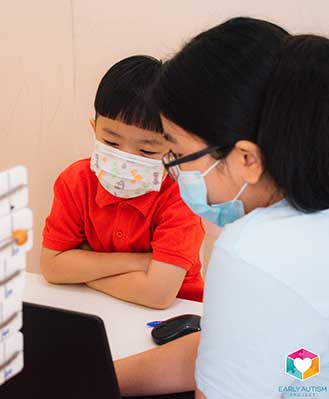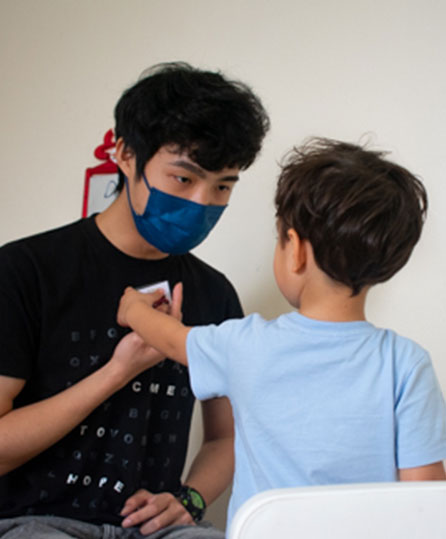0
Cart 0
Type and hit enter
The reasons why it is so important to identify red flags, symptoms and to get a diagnosis as soon as possible are due to the following reasons:
The brain is still developing and more malleable at a very young age. Therefore a child’s brain has higher potential to adapt, change and learn rapidly the younger they are.
The developmental delay is much smaller at a younger age (e.g. a 3 year old child demonstrating a 2 year delay versus a 7 year old child demonstrating a 5 year delay). The smaller the gap, the higher the likelihood of closing the gap.
The challenging behaviours a child with autism may demonstrate (e.g. repetitive or self-stimulatory behaviours, or self-injurious or aggressive behaviours) have only been practiced for a shorter amount of time the younger the child is.


Early identification is best. Schedule an initial appointment with us to learn more about your child and autism, or to find out more about our therapy programmes!
Before making an appointment for an Initial Screening, the child should have already received a prior diagnosis of autism spectrum disorder from an external clinician. The Initial Screening is a 2-hour appointment, where one of our EAP Supervisor will observe and play with the child, as well as discuss the child’s development, strengths, challenges, and subsequently provide you with a recommendation of strategies and programmes that EAP Malaysia can provide for the child. A written report will be provided to you following the appointment.
The Diagnostic Evaluation is a 2-hour appointment, where one of our EAP Malaysia Psychologists will observe and play with the child, as well as conduct an interview with the parents, to determine if your child has autism. The tools utilised for the Diagnostic Evaluation are the Childhood Autism Rating Scale (CARS) and the Diagnostic and Statistical Manual of Mental Disorders (DSM-V-TR). A written report will be provided to you following the appointment.
If your child meets any of the following red flag behaviours:
The Modified Checklist for Autism in Toddlers, Revised with Follow-Up (M-CHAT-R/F; Robins, Fein, & Barton, 2009) is a 2-stage parent-report screening tool to assess risk for Autism Spectrum Disorder (ASD). The M-CHAT-R/F is an autism screening tool designed to identify children 16 to 30 months of age who should receive a more thorough assessment for possible early signs of autism spectrum disorder (ASD) or developmental delay.
The American Academy of Pediatrics (AAP) recommends that all children receive autism-specific screening at 18 and 24 months of age, in addition to broad developmental screening at 9, 18, and 24 months. The M-CHAT-R/F, one of the AAP recommended tools, can be administered at these well-child visits.
If your child shows any of the above red flags or fails the M-Chat, it is important that you schedule a diagnostic evaluation as soon as possible. Our diagnosing consultants from Wisconsin Early Autism Project (WEAP) have shared some useful points that you should look out for when receiving a diagnosis. They are:


– The Diagnostic and Statistical Manual of Mental Health (5th edition) (DSM-5-TR).
– Autism Diagnostic Observation Schedule (ADOS)
– Autism Diagnostic Interview Revised (ADI-R)
– Observations of your child
– A thorough interview with parents/caregivers
Autism Spectrum Disorders (ASD) are neurological disorders featuring delayed or abnormal development in “social communication and interactions”; and “restricted, repetitive patterns of behaviour, interest, or activities”. It is a spectrum disorder in which their symptoms and severity vary widely across the core characteristic symptoms. It is defined by symptoms that appear before the age of 3 years old.
According to the Diagnostic and Statistical Manual of Mental Disorders 5 (DSM-5-TR) – the golden standard for diagnosis – ASD is characterised by 2 core areas:
Persistent deficits in social communication and social interaction across multiple contexts as manifested by the following, currently or by history:
Symptoms must be present in the early developmental period
Symptoms cause clinically significant impairment in social, occupational, or other important areas of current functioning
Early Learner | Intermediate Learner | Advanced Learner | |
Early Learner Skills | May not have much cooperation, imitation or attention. | Able to cooperate, imitate and attend in a one to one setting and possibly small group setting. | Able to cooperate, imitate and attend in a one to one setting and possibly small group setting. |
Communication & | Child may be nonverbal, use hand-leading and tantrums to communicate or may have some sounds or few words. | Child has ability to receptively learn nouns, verbs, people’s names, may have some expressive language (e.g. 2-3 word phrases), answer simple conversation questions. | Fluent in receptive understanding & expressive language. |
Play Skills | Very few play skills, may play repetitively or inappropriately with limited toys. | May be able to play with different toys and participate in simple preschool games. | May be able to play in group activities and sport. |
Social Skills | May be unaware of other people, prefer to play on his own, little or brief eye contact. | May have learned to play with others, able to take turns, share and stay with peer. | May struggle with literal thinking, may demonstrate some socially inappropriate behavior due to lack of understanding more complex social rules. |
References
American Psychiatric Association. (2013). Diagnostic and statistical manual of mental disorders (5th ed.). Arlington, VA: American Psychiatric Publishing.
National Institute of Child Health & Human Development (NICHD) (2013). What are the symptoms of Autism Spectrum Disorder (ASD). Retrieved from: http://www.nichd.nih.gov/health/topics/autism/conditioninfo/Pages/symptoms.aspx
Jochebed Isaacs (2014). What is Autism? [Power Point slides].
Robins, D. L., Fein, D., Barton, M. L. & Green, J. A. (2001). The modified checklist for Autism in Toddlers: An initial study investigating the early detection of Autism and Pervasive Developmental Disorders. Journal of Autism and Developmental Disorders 2001, 31(2) 131-144.
Adding {{itemName}} to cart
Added {{itemName}} to cart